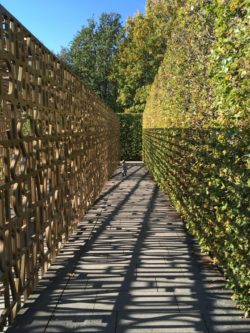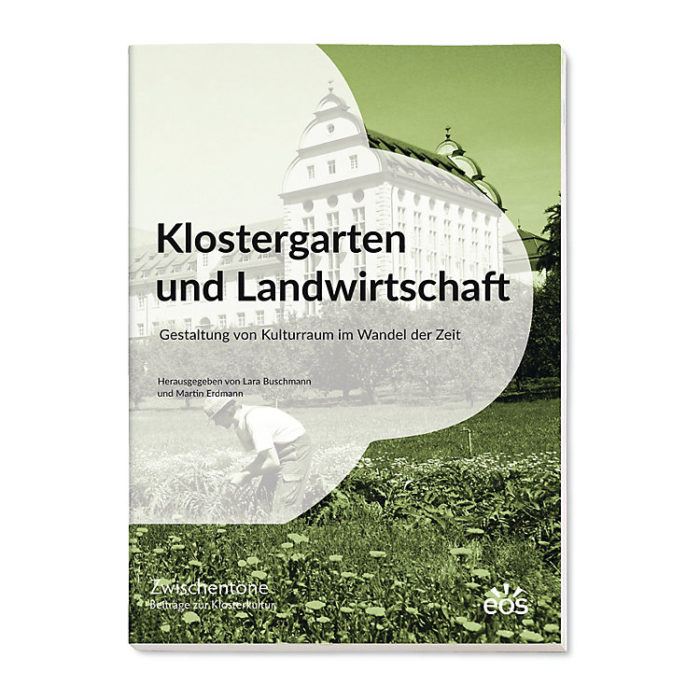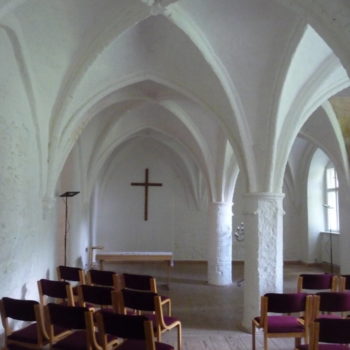»The place in the monastery where one is closest to God is not only the church, but the garden. It is there that the monks experience their greatest happiness.«
It is surprising to learn that this quotation has come down to us from very ancient times. It is attributed to St. Pachomius (ca. 292-346), who in the fourth century founded the first monasteries with community life in Egypt. He was a soldier before he became a monk, and accordingly the outward organisation of his monasteries was of a military nature. But especially as a soldier, he seems to have had a particular relationship with the peaceful life in the garden. And a high esteem for gardens goes along with the entire history of the development of Christian monasticism until today.
We want to dwell a little on the motif of the monastery garden with the help of a picture that shows a new, special garden. It is the so-called Christian Garden, and it is located in a district of Berlin that is otherwise not so much noticed, namely in Marzahn. There exists the enchanting site of the Gardens of the World, and after many years of visitors being captivated by the various Asian gardens in particular, this Christian garden has only recently been created.
If we take a closer look at this Christian garden, we come to think that this garden has taken the form of a monastic cloister garden. It is laid out in a square and enclosed by architecture that is easily reminiscent of the monastic cloister, at the centre of which there usually is a garden. This garden was already an artistic, symbolic garden in the Middle Ages, usually with a cross or fountain in the middle. It not so much served to provide for the needs of the monastery’s inhabitants, but for prayer and contemplation. Compared to the other gardens in Marzahn, it is striking that it looks particularly artificial. Its border is not only marked by a hedge running around it, but by an unusual metal mesh of words. This only exists here, however not in historical models of monastery gardens. A garden surrounded by words. This gave me a lot to think about.
This garden can inspire us in some ways. Christianity undoubtedly is a religion of words. Christ, the Son of God, in theology is identified as the Logos, the Word of the Father. For example, in the Gospel of John it says: »In the beginning was the Word. (…) And the Word became flesh and dwelt among us.«
If we now compare this garden with a classical monastery, we can discover another parallel: In the cloister surrounding the garden, originally there were benches meant for reading. The medieval monks read murmuring softly, so we can certainly imagine the monastery garden as being surrounded by spiritual words.
For biblical man, the garden is the lost paradise, the Garden of Eden, which Adam and Eve were forbidden to enter after the Fall. And indeed we very often also find the term Garden of Paradise for this archetypal monastic garden. With its four sides it marks the four cardinal points and the four elements, just as 4 is the symbolic number of creation, after 1 and 3, which embody the divine qualities, and 2 that embodies the two natures in Christ. The fact that the monks enclose this little paradise with holy words and chants is a beautiful idea: they guard the paradise and protect it through the word. On the other hand, the massive metal mesh may also symbolise the power of the word.
Admittedly, today there increasingly is a surfeit of the word. The world is flooded with a never-ending torrent of words that pours out in fibre optic cables and electromagnetic waves into the furthermost corners of life. Every word, whether uplifting or destructive, can be obtained at any point on earth. And here the monastery gardens at the present day have a very high value as refuges for contemplation of the word that is not uttered carelessly.
They direct us to the contemplation of God in his creation, which sings a constant song of praise. A creation that turns to its Creator without any sophistry or verbosity. Monastics are particularly aware of this, for they spend a considerable part of their lives singing the Psalms (19:1-5), where it says, among other things:
»The heavens declare the glory of God, and the skies proclaim the work of his hands. Day after day they pour forth speech; night after night they display knowledge. There is no speech or language where their voice is not heard. Their voice goes out into all the earth, their words to the ends of the world.«
In the monastery, church and garden are in close neighbourhood. Perhaps the garden is indeed the very place where the monk can turn most freely to his Creator, in silence and contemplation of the wonders of creation. This becomes all the more clear to us because St Benedict in his Rule refers to daily worship as servitutis pensum (Regula Benedicti 50, 4), or bounden duty imposed on the monk. In the divine service, the words from the Holy Scripture are given and, according to Benedict, the task is not to multiply them of one’s own accord, but to conform one’s inner being to them.
Now, in the garden, the spirit rests, and working with one’s hands on the cultivation and care of this small paradise proves to be a healing contact with the original conditio humana, that is, with that original inner peace which was intended for man and from which he vaulted himself through the pride of his spirit.
Here, in the garden, after his hybrid, failed flight of fancy, he finally stands once again on the steaming earth, amongst the fragrance of flowers and herbs, and listens to this silent hymn of praise, full of admiration and longing to share in it, too. That’s enough to the wise!






